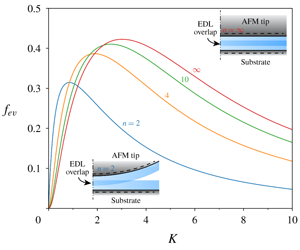Article contents
Electroviscous effects on the squeezing flow of thin electrolyte solution films
Published online by Cambridge University Press: 11 February 2020
Abstract

We present a detailed analysis of the electroviscous effect in the squeeze out of thin electrolyte films confined between two charged surfaces. The two charged surfaces consist of a curved surface and a flat surface, which closely simulate the tip–substrate configuration in the force measurement of electrolyte solutions with dynamic atomic force microscopy. In the lubrication limit, we find the analytical solution of the electroviscous-effect-modified squeezing flow field in the thin electrolyte film confined between the tip and substrate by solving the Nernst–Planck–Poisson/Navier–Stokes equation under the justified condition of pseudo-steadiness. We also derive the solution of the tip–substrate interaction, which comprises of a conservative electric double layer (EDL) force and an electroviscous-effect-enhanced dissipative hydrodynamic force. The current work focuses on the dissipative hydrodynamic force since the conservative EDL force has been well described by the well-known Derjaguin–Landau–Verwey–Overbeek theory. We introduce a power-law index ( $n$) for the tip surface, which enables an unprecedented quantitative characterization of the tip profile effect on the electroviscous effect. We observe a seemingly counter-intuitive effect that, for a given tip–substrate separation, the electroviscous effect is the strongest at one particular value of the zeta (
$n$) for the tip surface, which enables an unprecedented quantitative characterization of the tip profile effect on the electroviscous effect. We observe a seemingly counter-intuitive effect that, for a given tip–substrate separation, the electroviscous effect is the strongest at one particular value of the zeta ( $\unicode[STIX]{x1D701}$) potential and diminishes as the
$\unicode[STIX]{x1D701}$) potential and diminishes as the  $\unicode[STIX]{x1D701}$ potential departs from this value. We reveal the counterion conductivity of the EDL to be the governing factor for the electroviscous effect under a given
$\unicode[STIX]{x1D701}$ potential departs from this value. We reveal the counterion conductivity of the EDL to be the governing factor for the electroviscous effect under a given  $\unicode[STIX]{x1D701}$ potential. In addition to enhancing the dissipative hydrodynamic interaction force, the electroviscous effect modifies the velocity profiles in the thin electrolyte solution films such that they are much sharper.
$\unicode[STIX]{x1D701}$ potential. In addition to enhancing the dissipative hydrodynamic interaction force, the electroviscous effect modifies the velocity profiles in the thin electrolyte solution films such that they are much sharper.
- Type
- JFM Papers
- Information
- Copyright
- © The Author(s), 2020. Published by Cambridge University Press
References
- 11
- Cited by


